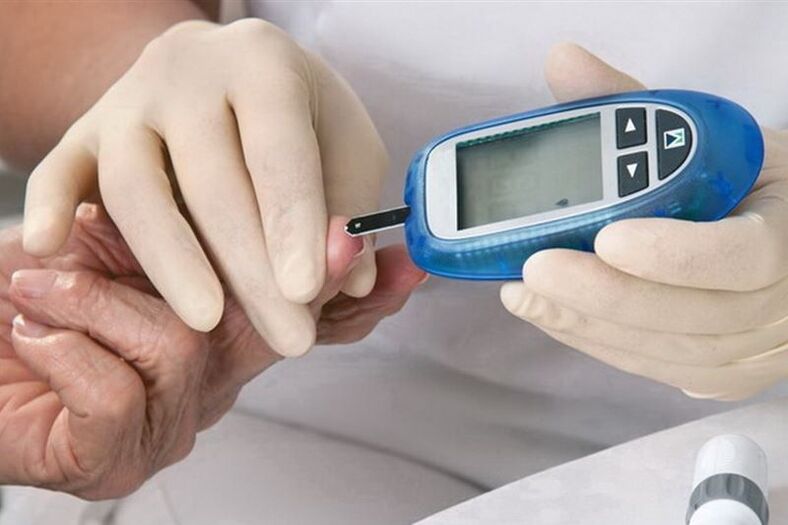Diabetes mellitus is considered the most common endocrine disease. Improper diet, lack of physical activity and genetic predisposition - these factors increase the risk of developing the disease. Today, around 347 million people in the world suffer from the disease. Over the past two decades, the number of cases has increased tenfold. If it is detected at an early stage, serious complications can be avoided. Therefore, it is important to know how diabetes manifests itself.
Causes of diabetes and its types
Diabetes is a disease characterized by metabolic disorders in the body. It is related to the pancreas not producing enough insulin hormone. Its deficiency leads to the accumulation of sugar in the body.

Normally, it should be processed into glucose by the action of insulin. This process is accompanied by discomfort and other symptoms. The sugar itself is excreted in large quantities with the urine, leading to gradual dehydration and an obsessive thirst.
The exact causes of the disease have not been studied to date. However, doctors identify a group of factors that increase the risk of its occurrence.
- genetic predisposition.
- Overweight.
- Pathology of the pancreas (cancer, pancreatitis).
- Exposure to viruses (flu, rubella and smallpox are especially dangerous).
- Frequent stress.
- Elderly age.
The classic classification of the disease provides for the allocation of its two forms: type 1 and type 2 diabetes. The first option is considered the most dangerous and is lifelong. To maintain the normal state of the body, it is necessary to continuously inject insulin intramuscularly. In the second type, the body produces this hormone, but not in the required amounts.
There are also the following types of diabetes: gestational diabetes, diabetes insipidus, diabetes insipidus, latent, autoimmune, copper. Each form is characterized by its own clinical picture and course features.
How does type 1 and type 2 diabetes manifest?
Diabetes is a serious disease. A person may not be aware of health problems for many years until falling into a hyperglycemic coma. Therefore, it is important to know the main manifestations of the pathology, taking into account its diversity.
Table 1. Manifestations of type 1 and 2 diabetes
| type of diabetes | Clinical picture |
|---|---|
| Type 1 diabetes |
|
| Type 2 diabetes |
|
The clinical picture may differ slightly depending on the age of the patient and their sex.
Signs of the onset of diabetes in children
Recognizing pathology in children is very easy. It is important to do this in a timely manner to avoid the development of a diabetic coma. It occurs spontaneously and can be fatal if the child does not receive medical attention.
The early signs of diabetes in children are:
- Urinating frequently and in large amounts. If your baby is still pooping, this symptom can be easily recognized. Urinary problems mostly occur at night. Parents often have to change diapers and bedding.
- The child is constantly thirsty. If diabetes is suspected, juices and juices should be replaced with water. If in this case your thirst does not subside, you should consult a doctor.
- Inconsistency in weight and feed intake. The child eats a lot, but is not in remission. Another option is also applicable: the child eats less, but the body weight increases rapidly.
In addition to these symptoms, diabetes can present with itching, constant fatigue even at rest, and dry mouth.
The onset of diabetes in men
The clinical picture of the disease in men does not differ from the general picture. However, inflammation of the foreskin, the entire urethra, may add to all the symptoms. This happens due to frequent urination. The concentration of sugar in the urine is quite high, leading to irritation of the tissues of the foreskin and the foreskin itself.
Diabetic disorders in women
In the normal sex, the onset of the disease is manifested by a feeling of intense thirst, drowsiness and itching. However, the pathological process often affects the reproductive system, which is accompanied by the following symptoms:
- Violation of the menstrual cycle. Bleeding may be completely absent for several months, and then appear as a blood clot.
- The appearance of sores on the mammary glands. They are often mistaken for allergies, but ongoing treatment has not yielded satisfactory results.
- Losing or gaining weight for no apparent reason.
The latter symptom is more common in women than in others. With a high-calorie diet, patients can lose up to 10 kg of weight. On the other hand, while following a strict diet, some people gain weight. Usually, such a violation is considered a malfunction in the hormonal system. Only after passing the tests were serious health problems revealed.
Symptoms of gestational diabetes
Gestational diabetes develops only in pregnant women. It has no specific external features. It is usually detected during routine exams, which are prescribed frequently to women in the office. The basis for diagnosis is the results of blood and urine tests.
The outward appearance of the disease is practically no different from that of type 1 and type 2 diabetes. We are talking about nausea, weakness, constant thirst. These symptoms do not occur in isolation and do not indicate toxicity. They develop mainly in the second and third trimesters.
The pregnancy form of the disease does not pose a direct threat to the woman and the fetus in the womb. However, it can negatively affect her general health, the course of pregnancy. High blood sugar levels lead to the birth of a high-birth-weight baby (4 kg or more).
Often this is seen as a precursor to obesity and the direct onset of diabetes in children. In some cases, there is a slight delay in development. Sometimes diagnosed as jaundice, hypoglycemia.
What to do if you have symptoms of diabetes?
If diabetes is suspected, you should not self-medicate or ignore the initial symptoms. This disease falls under the jurisdiction of an endocrinologist. However, a therapist can make a diagnosis.
To determine the presence of a pathological process, in any case, you need to seek medical help. The specialist will first listen to the patient's complaints, study the medical history, and conduct a physical examination. Only on the basis of these measures can a preliminary diagnosis be made. To confirm it, you will need to undergo a comprehensive examination.
Diagnostic
Any study on suspected diabetes is aimed at determining the level of glucose in the blood.
Usually, patients are recommended to have a blood test to look for sugar levels. Before delivery, you can not eat for 8-12 hours. Alcohol is also prohibited. Better to quit smoking. Normally, the glucose reading should be 5. 5 mmol per liter. If this parameter is 7 units or more, an additional test is indicated.
Patients are asked to undergo a glucose tolerance test. The analysis consists of several parts. First, the patient takes a standard fasting blood test. Then, in a medical facility, he drank a glass of sugary water (75 g of this substance per 200 ml of water). After 2 hours, he went for another blood test.
In a healthy person, the rate after the first study was up to 5. 5 mmol per liter, and after the second - up to 7. 8 mmol per liter. If these parameters are slightly exceeded (about a few tenths), the doctor will make a conclusion about pre-diabetes. Indicators much higher than these were indicative of diabetes.
Some are analytically indicated for glycated hemoglobin. With it, you can monitor your blood glucose status for the past 3 months. Typically, this number should be less than 5. 7%. With values between 5. 7-6. 4%, there is a high risk of type 2 diabetes.

In this case, the patient should discuss with the doctor about preventive measures. When the level of glycated hemoglobin is higher than 6. 5%, diabetes is likely. However, confirmation by additional tests is required.
Possible complications
The disease itself is not life-threatening, but is subject to a doctor's recommendation. Its complications are very dangerous. Among them, the following are the most common:
- Neuropathy. The disease is manifested by burning, severe pain and numbness in the lower abdomen. It develops due to metabolic disturbances in the central nervous system. Treatment is with drugs with thioctic acid. With timely medical help, the patient recovers the nerve tissue.
- Diabetes. Her symptoms are increasing rapidly. Therefore, the subjective patient was immediately hospitalized. At first, children may complain of dark circles under their eyes and mental retardation. There are several types of this condition, but ketoacidosis is the most common. It is characterized by the accumulation of toxins in the body, which rapidly destroy nerve cells.
- Nutritional ulcer. This is a serious pathology that significantly reduces a person's quality of life. If treatment is not started in time, trophic ulcers may begin to fester.
Diabetes can also lead to other health problems. They manifest themselves in the form of disruptions in the functioning of various organ systems (liver, kidneys, organs of vision).
Prevention of diabetes
First of all, it should be noted that the onset of type 1 diabetes is very unpredictable. The disease is mainly hereditary. Different viruses increase its ability to grow.
Type 2 diabetes is much easier to prevent. Its appearance directly depends on the quality of human life. Addiction, sedentary lifestyle, alcohol abuse - all these factors can contribute to the disease. Therefore, doctors make the following recommendations for prevention:
- Control body weight (try to eat reasonable and balanced).
- Monitor your blood pressure and, if necessary, see your doctor for treatment.
- Participate in challenging sports.
- Timely treatment of diseases, especially those related to the endocrine system.
If you follow these simple guidelines, you can protect yourself from diabetes. A healthy lifestyle and proper nutrition are the keys to a fully functioning body.
Diabetes is a dangerous disease that requires taking insulin for life. If you neglect treatment, the pathological process can become more complicated and lead to rather unpleasant consequences.
Among the following, diabetic coma, trophic ulceration of the lower extremities, and neuropathy should be noted. To protect yourself from such problems, it is important to know the initial symptoms of the disease, and if they appear, immediately consult a doctor. After passing the examination, which mainly consists of an assessment of blood glucose parameters, the specialist will be able to choose a therapy.



























